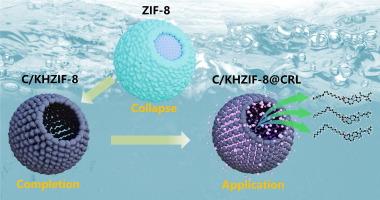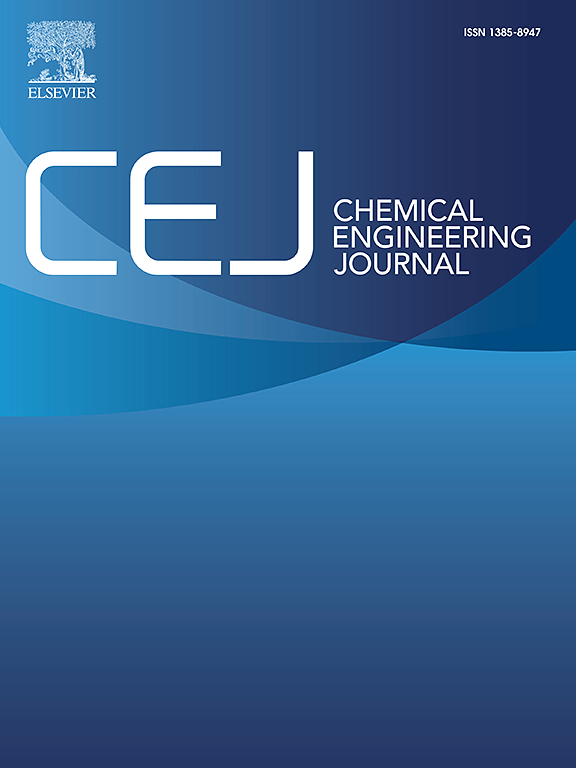Mof-derived hollow-open hierarchically porous carbon spheres for enzyme encapsulation and biocatalysis
IF 13.2
1区 工程技术
Q1 ENGINEERING, CHEMICAL
引用次数: 0
Abstract
The preparation of hollow hierarchically porous Zeolitic Imidazolate Framework-8 (ZIF-8), followed by its derivation into carbon materials, emerges as an effective approach to overcome the issues of limited pore size and poor stability encountered by traditional ZIF-8 in enzyme immobilization applications. In this study, a simple and distinctive pathway was employed to fabricate spherical ZIF-8 with a hollow-open hierarchically porous structure (KHZIF-8), which was carbonized into a promising immobilized enzyme carrier, hollow-open hierarchically porous carbon spheres (C/KHZIF-8-X, where X signifies the carbonization temperature). A suite of analytical techniques was utilized to elucidate the transformation of ZIF-8 into derived carbon. Compared to ZIF-8, C/KHZIF-8-X demonstrates enhanced chemical stability in aqueous systems for enzyme immobilization. C/KHZIF-8–800, produced through optimized carbonization, achieved Candida rugosa lipase (CRL) loading of 177.4 mg g−1 and relative activity of 81.4 %, while C/ZIF-8@CRL exhibited lower enzyme loading (66.3 mg g−1), and the relative activity based on unit enzyme amount decreased to 66.6 %. Furthermore, the successful encapsulation of catalase confirmed the potential of C/KHZIF-8–800 as a universal platform for biomolecule immobilization. In application, C/KHZIF-8–800@CRL catalyzed the synthesis of oleic acid sterol esters, achieving a maximum conversion rate of 80.9 %. This study shed new light on optimizing the structure and properties of ZIF-8 and developing MOF-based immobilized enzyme reactors.

用于酶包封和生物催化的mof衍生的空开分层多孔碳球
制备空心级孔咪唑酸分子筛框架-8 (ZIF-8),并将其衍生为碳材料,是克服传统ZIF-8在酶固定化应用中遇到的孔径有限和稳定性差问题的有效方法。本研究采用一种简单而独特的方法制备了空心开孔结构的球形ZIF-8 (KHZIF-8),并将其碳化成一种很有前途的固定化酶载体——空心开孔级孔碳球(C/KHZIF-8-X,其中 X 表示碳化温度)。利用一套分析技术阐明了ZIF-8转化为衍生碳的过程。与ZIF-8相比,C/KHZIF-8-X在酶固定的水体系中表现出更高的化学稳定性。优化炭化后得到的C/ KHZIF-8-800酶的载酶量为177.4 mg g−1,相对活性为81.4 %,而C/ZIF-8@CRL酶的载酶量较低,为66.3 mg g−1,单位酶量的相对活性为66.6 %。此外,过氧化氢酶的成功包封证实了C/ KHZIF-8-800作为生物分子固定的通用平台的潜力。应用中,C/KHZIF-8 - 800@CRL催化合成油酸甾醇酯,最大转化率为80.9 %。本研究为优化ZIF-8的结构和性能以及开发mof基固定化酶反应器提供了新的思路。
本文章由计算机程序翻译,如有差异,请以英文原文为准。
求助全文
约1分钟内获得全文
求助全文
来源期刊

Chemical Engineering Journal
工程技术-工程:化工
CiteScore
21.70
自引率
9.30%
发文量
6781
审稿时长
2.4 months
期刊介绍:
The Chemical Engineering Journal is an international research journal that invites contributions of original and novel fundamental research. It aims to provide an international platform for presenting original fundamental research, interpretative reviews, and discussions on new developments in chemical engineering. The journal welcomes papers that describe novel theory and its practical application, as well as those that demonstrate the transfer of techniques from other disciplines. It also welcomes reports on carefully conducted experimental work that is soundly interpreted. The main focus of the journal is on original and rigorous research results that have broad significance. The Catalysis section within the Chemical Engineering Journal focuses specifically on Experimental and Theoretical studies in the fields of heterogeneous catalysis, molecular catalysis, and biocatalysis. These studies have industrial impact on various sectors such as chemicals, energy, materials, foods, healthcare, and environmental protection.
文献相关原料
公司名称
产品信息
索莱宝
Tris (hydroxymethyl) aminomethane hydrochloride
索莱宝
phosphate-buffered saline
索莱宝
Tris (hydroxymethyl) aminomethane hydrochloride
索莱宝
Phosphate-buffered saline
索莱宝
Tris (hydroxymethyl) aminomethane hydrochloride
索莱宝
Phosphate-buffered saline
阿拉丁
Catalase
阿拉丁
p-nitrophenol
阿拉丁
2-methylimidazole
阿拉丁
Catalase
阿拉丁
p-nitrophenol
阿拉丁
2-methylimidazole
阿拉丁
Catalase
阿拉丁
p-nitrophenol
阿拉丁
2-methylimidazole
阿拉丁
Catalase
阿拉丁
p-nitrophenol
阿拉丁
2-methylimidazole
 求助内容:
求助内容: 应助结果提醒方式:
应助结果提醒方式:


